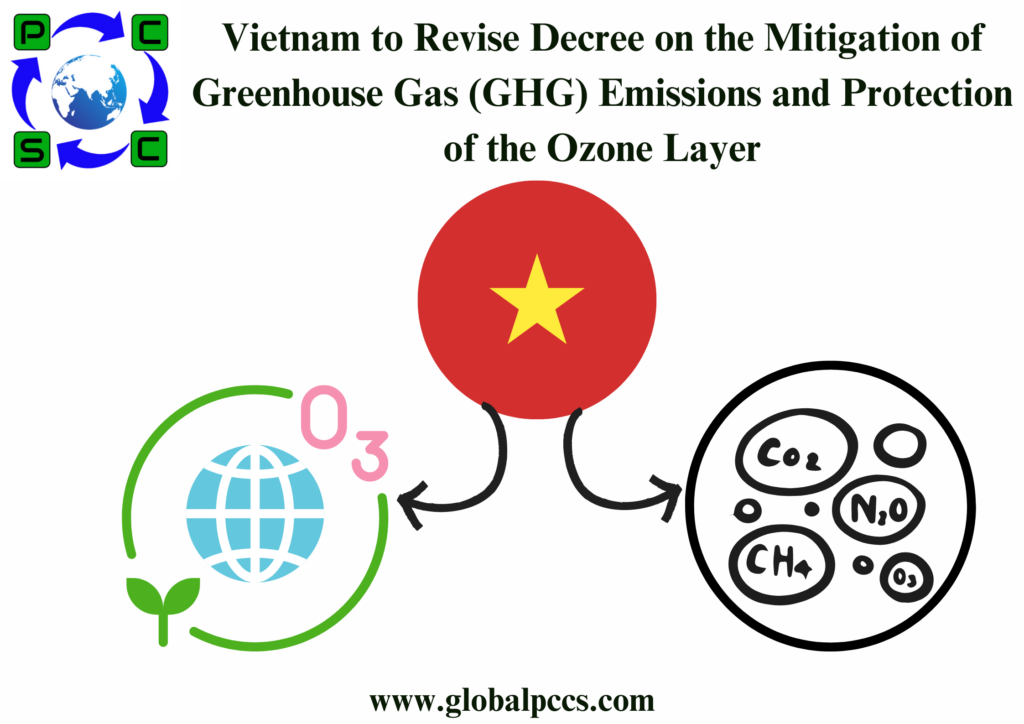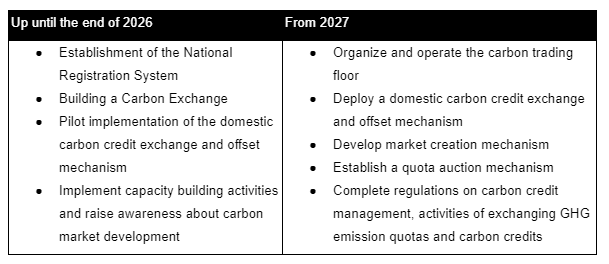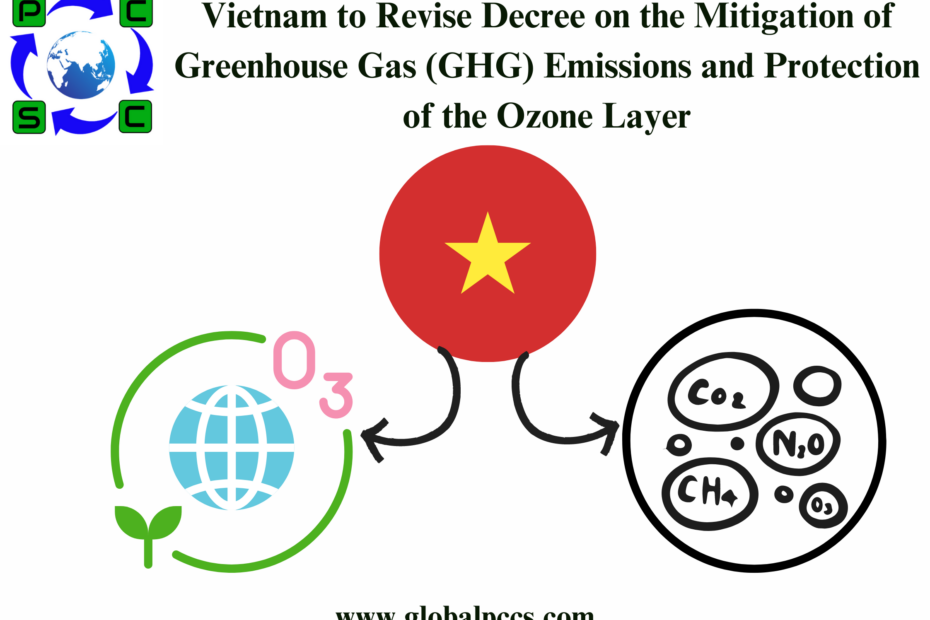 As per an official notice issued on July 5, 2024, Vietnam has proposed a draft to revise Decree No. 06/2022/ND-CP on Mitigation of GHG Emissions and Protection of Ozone Layer. Decree No. 06/2022/ND-CP is a supplementary regulation for Vietnam’s Law on Environmental Protection 2020. It elaborates on the requirements for the mitigation of GHG emissions, the organization and development of the carbon market, and the protection of the ozone layer.
As per an official notice issued on July 5, 2024, Vietnam has proposed a draft to revise Decree No. 06/2022/ND-CP on Mitigation of GHG Emissions and Protection of Ozone Layer. Decree No. 06/2022/ND-CP is a supplementary regulation for Vietnam’s Law on Environmental Protection 2020. It elaborates on the requirements for the mitigation of GHG emissions, the organization and development of the carbon market, and the protection of the ozone layer.
Key Revisions
- Revisions to the mitigation of GHG emissions
1.1 Roadmap for facilities to carry out GHG emission mitigation (Article 7)
Currently, Decree No. 06/2022/ND-CP requires establishments on the list of sectors and facilities emitting GHG to create an inventory of GHG emissions. The list of involved facilities can be found in Decision 01/2022/QD-TTg, which covers enterprises from sectors such as energy, transportation, construction, industrial processes, agriculture, forestry and land use, as well as waste.
According to Article 7 of Decree No. 06/2022/ND-CP, these facilities must carry out GHG emission mitigation based on their own GHG emissions mitigation plans. They are required to implement GHG emissions inventories, formulate and execute GHG emission mitigation plans according to the quotas allocated by the Ministry of Natural Resources and Environment (MONRE).
The draft mainly revises the roadmap for these facilities to carry out GHG emission mitigation. For example, the implementation period is changed from “2026 to 2030” to “2025 until the end of 2030.” Responsibilities for facilities that have not been allocated GHG emission quotas are newly clarified—they are responsible for developing and implementing plans to reduce GHG emissions at the grassroots level.
1.2 Requirements for GHG inventory development (Article 11)
It is newly required that the facility’s biennial GHG inventory report must include the GHG inventory results of the two most recent years.
New responsibilities clarified for involved facilities are as follows:
- For facilities that are allocated GHG emission quotas, GHG inventories and bi-annual GHG inventory reports must be carried out from 2025 onwards, following Form No. 06 Appendix II issued with this Decree, and verified by the designated verifying unit specified in Article 14 of this Decree.
- Facilities that have not been allocated GHG emission quotas must submit applications for verification of GHG inventory results and facility-level GHG emission mitigation plans to the Provincial People’s Committee for approval. Detailed procedures and required documents are stipulated in this Draft.
1.3 Requirements for GHG emissions quotas allocation (Article 12)
This draft provides two plans for allocating GHG emissions quotas. In both plans, Vietnam will primarily allocate GHG emission quotas to thermal power plants, iron and steel production facilities, and cement production facilities from 2025 to 2026. Establishments allocated quotas are allowed to exchange GHG emission quotas and carbon credits on the Carbon Exchange, following the roadmap specified in Article 17 of this Decree. Details about the allocation plan can be found in the Draft.
1.4 Requirements for verifying units (Article 14)
The requirements for verifying units are revised. They must have the competency capacity that meets the requirements specified in the international standard ISO 14064-3, ISO 14065 or the national standard TCVN ISO 14065.
- Revisions to the organization and development of domestic carbon market
2.1 Participants in the domestic carbon market (Article 16)
This draft clarifies that participants in carbon credit exchange can be foreign organizations with legal status in Vietnam, in addition to Vietnamese organizations and individuals.
2.2 Development roadmap and deployment time of domestic carbon market (Article 17)
The newly proposed roadmap is as follows.

2.3 Certification of eligible carbon credit, GHG emission quotas exchanged on the domestic carbon market (Article 18)
The draft mainly introduces a National Registration System, which will serve the management of GHG emission quotas and carbon credits. The MONRE will preside over and coordinate with relevant agencies to develop and promulgate regulations on the management and operation of the National Registration System.
The national registration system includes:
- Information technology infrastructure for GHG emission quotas and carbon credits;
- Software system for management, operation, and exploitation of information on GHG emission quotas and carbon credits;
- Database and information on the transaction situation of GHG emission quotas and carbon credits in the territory of Vietnam;
- Database on carbon credit exchange and offset mechanism specified in Clause 1, Article 20 of this Decree.
2.4 Exchange of GHG emission quotas and carbon credits on domestic carbon market (Article 19)
The draft details regulations on the time and procedures for carrying out activities: i) buy and sell GHG quotas and carbon credits; ii) pay back, transfer, borrow GHG emission quotas.
2.5 Carbon credit exchange and offset mechanism (Article 20)
Details are proposed for the carbon credit exchange and offset mechanism. According to the draft, the carbon credit exchange and offset mechanism include:
- Domestic carbon credit exchange and offset mechanism.
- Mechanism for the exchange and offset of international carbon credits as per international agreements or treaties between Vietnam and foreign signatories.
- Carbon credit exchange and offset mechanism within the framework of the United Nations Framework Convention on Climate Change, treaties, and international agreements to which Vietnam is a member.
- Other international carbon credit exchange and offset mechanisms.
Areas where projects can be implemented according to the carbon credit exchange and offset mechanism are:
- Energy production
- Energy distribution
- Energy consumption
- Manufacturing industry
- Chemical industry
- Construction
- Transportation
- Mining and processing of minerals
- Metal production
- Emissions from fuel (solid fuel, oil, and gas)
- Emissions from the production and consumption of Halocarbons and Sulfur hexafluoride
- Use of solvents
- Waste treatment
- Afforestation and reforestation; reducing GHG emissions through limiting forest loss and degradation, conserving and enhancing carbon stocks, and sustainably managing forest resources (REDD+)
- Agriculture
- Other fields in accordance with the guidance of the United Nations Framework Convention on Climate Change and the provisions of Vietnamese law.
- Revisions regarding the protection of the ozone layer
Requirements for controlled substances are revised. The current Decree No. 06/2022/ND-CP regulates that “Organizations possessing equipment containing controlled substances: air conditioners with a nominal cooling capacity greater than 26.5 kW (90,000 BTU/h) and with a total nominal cooling capacity greater than 586 kW (2,000,000 BTU/h); industrial refrigeration equipment with electric power greater than 40 kW” shall register manufacture, export and import. Now the entity is changed into “Organizations that own equipment containing controlled substances: air conditioners with a nominal cooling capacity of 26.5 kW (90,000 BTU/h) or more; Industrial refrigeration equipment with electrical capacity of 40 kW or more”.
In cases where the recycling or reuse of controlled substances is not possible, treatment shall be carried out in accordance with the provisions of the law on hazardous waste management. It is newly proposed that controlled substances, after recycling, are not prohibited from consumption and are not included in the total national consumption.
- Amendment to Appendixes
The amendments involve:
- Appendix I: Targets to reduce GHG emissions in all sectors by 2030.
- Appendix III, Form No. 01: The results of reducing GHG emissions in the industry.
- Appendix V, Form No. 01: Application for carbon credit confirmation.
- Appendix V, Form No. 02: List of measures and activities to encourage emission reduction for projects under the international carbon credit exchange and offset mechanism according to international agreements or treaties between Vietnam and foreign signatories.








 Authorised IMDS & CDX Training & Consulting partner for
Authorised IMDS & CDX Training & Consulting partner for





